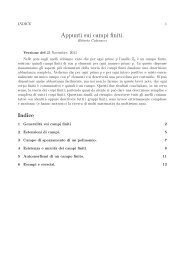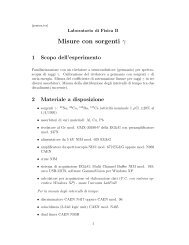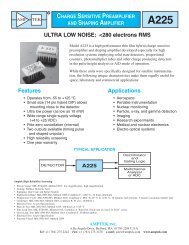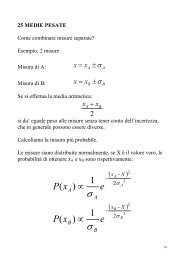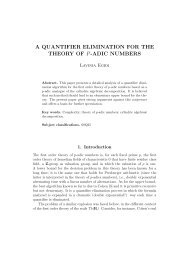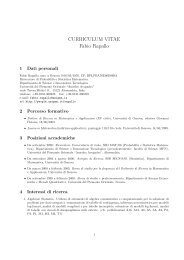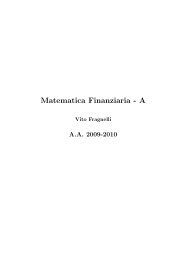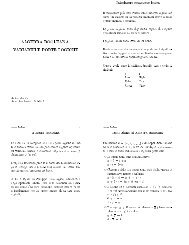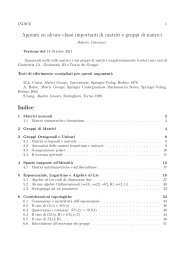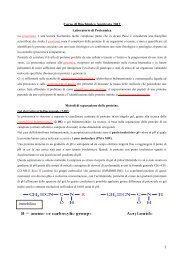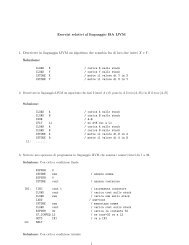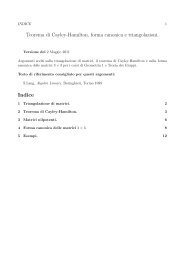Authentication and Access Delegation with User-Released Certificates
Authentication and Access Delegation with User-Released Certificates
Authentication and Access Delegation with User-Released Certificates
Create successful ePaper yourself
Turn your PDF publications into a flip-book with our unique Google optimized e-Paper software.
ABSTRACT<br />
<strong>Authentication</strong> <strong>and</strong> <strong>Access</strong> <strong>Delegation</strong><br />
<strong>with</strong> <strong>User</strong>-<strong>Released</strong> <strong>Certificates</strong><br />
Lavinia Egidi<br />
Dipartimento di Informatica<br />
Univ. del Piemonte Orientale<br />
Spalto Marengo 33<br />
15100 Aless<strong>and</strong>ria, Italy<br />
lavinia@mfn.unipmn.it<br />
We propose an authentication <strong>and</strong> access delegation system<br />
based on an unconventional use of X.509 certificates. It allows<br />
users to connect from any untrusted machine <strong>and</strong> to<br />
define dynamically a group of trusted co-workers. It is low<br />
cost, doesn’t need unusual software nor hardware on the<br />
client’s side, <strong>and</strong> offers a good degree of security <strong>with</strong>out<br />
requiring that the user be too careful. The underlying idea<br />
is to enable users to release their own certificates <strong>with</strong> very<br />
short life span (or usable just once) to authenticate themselves<br />
to the server.<br />
Keywords<br />
<strong>Authentication</strong>, access delegation, user-released certificates,<br />
short-lived <strong>and</strong> one-time certificates.<br />
1. INTRODUCTION<br />
We propose a short-lived password authentication system<br />
based on public-key certificates that allows for user-defined<br />
delegation of access. It permits a high degree of user mobility<br />
<strong>and</strong> is low-cost.<br />
Our aim in designing the protocol was to offer flexible<br />
authentication mechanisms, while preserving acceptable security<br />
levels, using off-the-shelf browsers <strong>and</strong> a commonly<br />
used server. We specifically had in mind a highly mobile<br />
user, not very security conscious, that should not be charged<br />
<strong>with</strong> much responsibility, <strong>and</strong> that needs dynamical sharing<br />
of data. In other words (a) our user can need to access<br />
sensible information on a web-server from any (untrusted)<br />
machine; (b) our user needs to share documents <strong>and</strong> information<br />
<strong>with</strong> selected co-workers; (c) the sharing groups<br />
change in time <strong>and</strong> must be managed in a dynamical way;<br />
(d) we cannot depend upon the user to follow a strict security<br />
protocol; (e) we do not wish to equip the user <strong>with</strong><br />
expensive hardware; (f) we must assume very ordinary hard-<br />
Permission to make digital or hard copies of all or part of this work for<br />
personal or classroom use is granted <strong>with</strong>out fee provided that copies are<br />
not made or distributed for profit or commercial advantage <strong>and</strong> that copies<br />
bear this notice <strong>and</strong> the full citation on the first page. To copy otherwise, to<br />
republish, to post on servers or to redistribute to lists, requires prior specific<br />
permission <strong>and</strong>/or a fee.<br />
SAC ’03 Melbourne, Florida USA<br />
Copyright 2003 ACM 1-58113-624-2/03/03 ...$5.00.<br />
Maurizio Melato<br />
NICE srl<br />
Via Serra 33<br />
14020 Camerano Casasco, Asti, Italy<br />
maurizio@nice-italy.com<br />
ware <strong>and</strong> software on the remote host; (g) we still wish to<br />
maintain a reasonable level of security.<br />
The prototypical user we initially had in mind is a student<br />
at our University; most of our students live in their<br />
own home towns, in an area of up to 30-50 km from the<br />
University buildings. The University buildings are in three<br />
different towns <strong>and</strong> not even grouped in campuses.<br />
Although our situation is somewhat extreme, the system<br />
we propose has features that can be interesting for lowbudget<br />
companies, for non critical or non educated staff<br />
of large companies, for flexible access management in large<br />
structures.<br />
The underlying idea is to release to end-users certification<br />
authorities (CA), in order to enable them to create their<br />
own certificates <strong>and</strong>, in turn, CAs. The certificates signed<br />
by user-CAs have very short time validity, thus allowing for<br />
careless use in non trusted environments. Releasing a subordinate<br />
CA to another user, <strong>and</strong> properly setting a configuration<br />
file on the web server, end-users can grant <strong>and</strong><br />
revoke access to areas of their own directories on the server<br />
to share information <strong>with</strong> co-workers in a controlled <strong>and</strong><br />
dynamic way.<br />
As a variant of the scheme, we also present a non conventional<br />
implementation of a challenge-response authentication<br />
mechanism using public-key certificates that yields<br />
the protection of a one-time password at the low cost of<br />
a CD or floppy disk, <strong>with</strong> very ordinary hardware requirements<br />
on the end-host from which the roaming user logs in.<br />
The higher security level is paid in terms of complexity on<br />
the server side. In this setting, user released certificates incorporate<br />
r<strong>and</strong>om information obtained from the web server<br />
<strong>and</strong> serve as one-time passwords.<br />
We present our ideas in the framework of directory access<br />
via a web interface, <strong>and</strong> web-server based access control,<br />
mainly because this was the problem we originally addressed.<br />
The stress, though, is on the mechanism <strong>and</strong> on<br />
its features. Our ideas have wider application. The scheme<br />
could have a major role in building a simple collaborative<br />
infrastructure or it can be integrated <strong>with</strong> any authorization<br />
system for implementation of access control to services<br />
offered by an Internet portal, as support for collaborative<br />
engineering architectures.<br />
Next section discusses our scheme in the context of related<br />
research. In Section 3 we review some concepts about certificates<br />
<strong>and</strong> certificate based access control, that we need
in the following. Then, in Section 4 we outline the scheme<br />
based on short-lived certificates. Section 5 describes the<br />
challenge-response variant. The implementation is discussed<br />
in Section 6. We analyze in Section 7 the security of our system.<br />
We conclude <strong>with</strong> some additional remarks <strong>and</strong> future<br />
work.<br />
2. RELATED WORK<br />
Secure access for a mobile user is certainly possible using<br />
specialized hardware (challenge response devices, smartcards,<br />
etc.). But we rule out this possibility since we don’t<br />
want to give costly hardware to our users <strong>and</strong> we want to<br />
enable them to connect to our web-server even from a computer<br />
in an Internet Café. <strong>Authentication</strong> <strong>with</strong> certificates<br />
via a web-server would be fine, except that the certificate<br />
(along <strong>with</strong> the corresponding private key) is bound to remain<br />
in the browser’s database, unless explicitly deleted by<br />
the user. But, as we said, we can’t assume that our users<br />
are too careful in deploying a security protocol.<br />
Therefore we must work <strong>with</strong> ordinary hardware <strong>and</strong> software<br />
on the client side, <strong>and</strong> still protect the user from accidental<br />
misusage of the cryptographic tools on which authentication<br />
is based.<br />
The non-conventional use of certificates makes it possible<br />
to base authentication on X.509 certificates (<strong>and</strong> to use<br />
off-the-shelf software <strong>and</strong> no expensive hardware to do this)<br />
from any untrusted host, eliminating the risk of leaving sensible<br />
data on untrusted machines. There are access control<br />
systems based on public key authentication mechanisms <strong>and</strong><br />
certificates, like for instance Akenti [17], [1]. Akenti provides<br />
means to implement security policies in a flexible way, but<br />
it doesn’t solve our problem of a non security conscious user<br />
in an untrusted environment.<br />
In addition, access delegation is of great interest in the<br />
domain of collaborative engineering [14]. A large amount of<br />
work is being done both in the industrial <strong>and</strong> in the academic<br />
world (see for instance [15],[4]), to provide tools for sharing<br />
information <strong>and</strong> services, <strong>and</strong> the security aspects are still<br />
under investigation [5].<br />
The LAXCP project of the CIC Research Projects Group<br />
(the CIC is the academic consortium of twelve US Universities)<br />
has specifically addressed the issue of authentication<br />
of students on <strong>and</strong> off campus, using X.509 certificates. In<br />
their final report [3], they highlight, among other things,<br />
the usefulness of short-lived certificates. <strong>Authentication</strong> is<br />
carried out in a Kerberos based manner <strong>and</strong> certificates are<br />
used to implement authorization policies (see also further<br />
developments in [11]).<br />
The LAXCP project is not an isolated case of use of certificates<br />
<strong>with</strong> a short validity period for authorization purposes.<br />
In [12], the authors present a framework for secure access to<br />
information servers based on temporary certificates. In their<br />
setting, users hold a secret key in a hardware token. The<br />
corresponding certificate is kept in a database on the server<br />
side. <strong>User</strong>s authenticate themselves signing a r<strong>and</strong>om string<br />
sent by the server; the server checks the signature using the<br />
certificate stored in the database. It then releases temporary<br />
certificates that allow for access to information servers<br />
(a public-key version of Kerberos’ tickets [10]).<br />
Short-lived certificates are also discussed in [8] for authorization<br />
in an intranet context, where user mobility is an<br />
issue. The short validity period of certificates protects the<br />
user from leaving behind sensible information.<br />
“Personal CAs” have been introduced in [6] for authentication<br />
of components in a P.A.N., a wireless network consisting<br />
of several units located close to the user. Since the<br />
personal CA is a root CA <strong>and</strong> the trust domain is limited to<br />
the user’s P.A.N., the concept only rescales the usual model<br />
of Public Key Infrastructure to a restricted environment.<br />
3. OVERVIEW ON CERTIFICATES<br />
We briefly review the main concepts about digital certificates<br />
that will be useful in the following.<br />
A public key certificate is a (digital) document signed by<br />
an authority that binds a public key to a certain identity. It<br />
is also known as “digital ID”.<br />
An authority that releases certificates is called Certification<br />
Authority (CA). It consists of a (cryptographically secure)<br />
key-pair for signature <strong>and</strong> a certificate that binds its<br />
public key to its identity <strong>and</strong> states that the key-pair can be<br />
used for releasing public-key certificates. The CA certificate<br />
can be released by another CA or can be self-released. A<br />
company that needs certificates for internal use, will typically<br />
have a self-appointed CA. A self-appointed CA is also<br />
called “root CA”. Any CA can release public-key certificates,<br />
but also enable somebody else to sign certificates, i.e.<br />
release a CA certificate. Finally CAs can sign Java tm applets<br />
to guarantee that they can be trusted. Signed applets can<br />
be granted privileges to write to the client’s disk.<br />
The proposed st<strong>and</strong>ard (<strong>and</strong> widely used) format for certificates<br />
is the X.509, described in [7]. Typical fields of X.509<br />
certificates are: version, serial number, signature algorithm<br />
ID, issuer name, validity period, subject (user) name, subject<br />
public key information, issuer unique identifier (version<br />
2 <strong>and</strong> 3 only), subject unique identifier (version 2 <strong>and</strong> 3<br />
only), extensions (version 3 only), signature on the above<br />
fields. The subject’s name field (DN which st<strong>and</strong>s for “Distinguished<br />
Name”) consists of a number of subfields: in the<br />
following we refer to CN (“Common Name”) <strong>and</strong> OU (“Organization<br />
Unit”). Among Version 3 Extension Fields, the<br />
“Basic Constraint” extension, indicates whether the subject<br />
is a CA or not.<br />
A hierarchy of certificates (a certificate, <strong>and</strong> the certificate<br />
of the CA that signed it, <strong>and</strong> so on up to the root CA) can<br />
be compounded in a unique file, called certificate chain. A<br />
certificate chain can be complete, to the root CA, or partial,<br />
to some intermediate CA.<br />
A CA periodically releases a Certificate Revocation List<br />
(CRL) in which it publishes revoked certificates that have<br />
not yet expired, but that are no longer valid because, say,<br />
the corresponding secret key has been compromised, or the<br />
user has changed status, etc.<br />
Browsers are commonly capable of managing certificates.<br />
They maintain per-user databases of personal certificates<br />
<strong>and</strong> secret keys associated to them. The secret key database<br />
is often encrypted <strong>and</strong> protected by a password, which is<br />
needed in order to modify the database <strong>and</strong> to use its contents<br />
(but not all browsers enforce the use of password protection<br />
for the secret keys).<br />
In order to add a new user certificate <strong>and</strong> secret key pair<br />
to the browser’s database, the user must request to “import”<br />
the file containing both of them. File format PKCS#12 [16]<br />
is accepted by Netscape <strong>and</strong> InternetExplorer.
On the server side, we refer to the Apache Web Server [2]<br />
<strong>with</strong> the module mod_ssl [13].<br />
Apache can be configured to work at various levels of security.<br />
Configuration directives can be given at server level<br />
or even on a per-directory basis. This means that for each<br />
single directory specific access permissions can be granted.<br />
Per-directory directives are read by the server at each access.<br />
Therefore they can be reconfigured at any time <strong>and</strong><br />
changes take effect immediately (as opposed to server level<br />
configuration directives that are read only at start-up time).<br />
An SSL-enabled Apache web server can be configured to<br />
dem<strong>and</strong> a certificate of the client that is requesting a secure<br />
(https) connection. In order to verify the validity of the<br />
client’s certificate, it also checks the CRLs of CAs in the<br />
certificate chain in a specified directory (even CRLs of CAs<br />
that are not explicitly listed as trusted by the server). Directory<br />
access can be granted based on data in any fields of<br />
the user’s certificate (<strong>and</strong>/or on general parameters of the<br />
connection).<br />
The server looks for directory level directives in a file<br />
called (by default) .htaccess, in each directory of the path<br />
of the file that is being accessed, in descending order.<br />
4. TEMPORARY CERTIFICATES<br />
The whole functionality is based on the idea that users<br />
are granted permission to release certificates.<br />
The Organization, has a (maybe self-appointed) certification<br />
authority; let us call it Main CA (MCA). It issues to<br />
each authorized user a child CA (which we refer to as <strong>User</strong><br />
CA or UCA) <strong>with</strong> permission to release end-user certificates<br />
<strong>and</strong> new CAs. The UCA’s private key is given to the user<br />
on a hardware token (a CD or a floppy disk) encrypted using<br />
some symmetric cipher. The secret encryption key is<br />
given separately to the user, in the form of a password. The<br />
public-key certificate of the UCA signed by MCA is also<br />
saved on the hardware token.<br />
For privacy protection, each user <strong>and</strong> their UCAs are identified<br />
<strong>with</strong> numerical IDs, rather than their names.<br />
4.1 Mobility<br />
Briefly, the user Fred lets his personal CA sign a certificate<br />
<strong>with</strong> very-short (two or three minutes) time validity, <strong>and</strong><br />
presents it to the server as he requests access.<br />
The access authorization is given by the server after a<br />
check on the validity of the certificate <strong>and</strong> on the identity of<br />
the issuer. The .htaccess file might look like this:<br />
SSLRequire (<br />
%{SSL_CLIENT_CERT_CHAIN_1} == file("UCA.pem"))<br />
The directive SSLRequire is used to allow access to a directory<br />
based on the truth value of a boolean expression.<br />
The file UCA.pem contains the PEM encoded version of the<br />
certificate of Fred’s UCA, <strong>and</strong> SSL_CLIENT_CERT_CHAIN_n is<br />
a variable that takes as its value the PEM encoded certificate<br />
of the n-th certificate up the client’s certificate chain<br />
(for n = 0 it is the client’s certificate). Therefore, the directive<br />
above instructs the server to test that the client’s<br />
certificate is issued by Fred’s UCA.<br />
Notice that the check is on the certificate of the issuer<br />
of the temporary certificate. The validity of the short-lived<br />
certificate proves to the server that the user that is requesting<br />
access is in possession of the secret key of the UCA;<br />
the temporary certificate does not convey other information,<br />
since any UCA can sign whatever it chooses to. Moreover,<br />
checking the issuer’s certificate against the file UCA.pem (as<br />
opposed to checking just the issuer’s identity, say) serves to<br />
counter impersonation attacks in which any other user of<br />
the same company, who has a regular UCA released by the<br />
MCA, releases a CA to the name of Fred, <strong>and</strong> signs <strong>with</strong> it<br />
short-lived certificates to access Fred’s area on the server.<br />
More in detail, a secure connection is a four step process:<br />
1. Connection to the Web Server in order to:<br />
(a) import into the browser the CA <strong>with</strong> which the<br />
applet has been signed (see next item), so that<br />
the applet will be trusted<br />
(b) download the signed applet<br />
2. Certificate Generation, that requires<br />
(a) loading the UCA’s private key (a PKCS#12 file)<br />
from the hardware token<br />
(b) getting the user’s password <strong>and</strong> decrypting the<br />
UCA’s secret key<br />
(c) compiling <strong>and</strong> signing the certificate<br />
(d) converting the certificate chain in PKCS#12 format<br />
3. Certificate Importation<br />
4. Connection<br />
If the temporary certificates have very short time validity,<br />
then synchronization is an issue. We feel that we cannot<br />
assume that an untrusted host has accurate time. Therefore,<br />
in order to set the proper validity interval for the certificate,<br />
the applet must download date <strong>and</strong> time from the server.<br />
We discuss in Section 6 how this can be realized <strong>and</strong> what<br />
we have done.<br />
We anticipate that the UCA’s private key is decrypted<br />
<strong>and</strong> used only by the trusted (signed) applet from the Organization,<br />
that cares not to leave sensible data behind.<br />
4.2 <strong>Access</strong> <strong>Delegation</strong><br />
But to use the full potentiality of being appointed Certification<br />
Authority, Fred can also delegate to other people access<br />
to areas in his directories, maintaining the same secure<br />
authentication mechanisms <strong>and</strong> dynamically <strong>with</strong>out having<br />
to inform the system administrator. The idea is simply to<br />
iterate the procedure: Fred releases a guest CA (GCA) to<br />
Mary, <strong>and</strong> Mary will use it to generate short-lived certificates<br />
following the procedure outlined above.<br />
Let’s analyze the details of how this works.<br />
Fred releases to Mary a CA certificate to her (numerical)<br />
name MMMMM, <strong>with</strong> the field OU set to FFFFF (the use of the<br />
latter will be clear later), <strong>and</strong> a suitable life span.<br />
Fred maintains in his home directory one shared directory<br />
<strong>and</strong> one private directory. (The discussion can be generalized<br />
to more than one private <strong>and</strong> one shared directories.)<br />
The .htaccess file in the home directory allows access to<br />
any one who has a certificate released by Fred’s CA or by a<br />
GCA released by Fred’s CA:<br />
SSLRequire (<br />
%{SSL_CLIENT_CERT_CHAIN_1} == file("UCA.pem")<br />
OR %{SSL_CLIENT_CERT_CHAIN_2} == file("UCA.pem"))
Again, this counters impersonation attacks.<br />
No one is allowed by the web server reads or writes in this<br />
directory. Basically the directory is reserved for administrative<br />
purposes.<br />
<strong>Access</strong> to any subdirectory is conditioned to access to the<br />
home one (see [2]). Therefore only Fred or any of his guests<br />
are considered for access to the private or the shared directory.<br />
The private directory is protected as follows:<br />
SSLRequire (<br />
%{SSL_CLIENT_CERT_CHAIN_1} == file("../UCA.pem")<br />
AND %{SSL_CLIENT_S_DN_OU} != "FFFFF")<br />
The first line tells the server to accept only certificates<br />
released by Fred. The second line is to check that the client’s<br />
certificate is not a GCA released by Fred.<br />
<strong>Access</strong> to the shared directory needs not be limited since<br />
the directory is shared among all users that are admitted to<br />
the home directory.<br />
A finer sharing policy is possible, <strong>and</strong> it requires that Fred<br />
set up properly his account. Fred can share different directories<br />
<strong>with</strong> different groups of people. In order to do so, Fred<br />
must customize the .htaccess file in each one of the shared<br />
directories, to define who is admitted to share it. The file<br />
will look for instance like this:<br />
SSLRequire ( %{SSL_CLIENT_I_DN_CN} == "MMMMM"<br />
OR %{SSL_CLIENT_I_DN_CN} == "JJJJJ" )<br />
(i.e. the issuer must be either MMMMM or JJJJJ) in order to<br />
admit Mary (MMMMM) <strong>and</strong> John (JJJJJ).<br />
Notice that the general admittance (i.e. to Fred’s home<br />
directory) is granted based on Fred’s permission (his UCA<br />
must be the last or second-last issuer in the chain), that is,<br />
the server protects Fred’s data against intruders. But Fred<br />
manages the sharing of his subdirectories.<br />
In the directory specified by the SSLCARevocationPath<br />
variable in the server’s httpd.conf file, users keep the revocation<br />
lists of their CAs. When Fred’s cooperation <strong>with</strong><br />
Mary is finished, Fred revokes Mary’s GCA certificate, <strong>and</strong><br />
releases an updated revocation list. Fred uploads the revocation<br />
list to the server <strong>and</strong> the server updates the symbolic<br />
links in the directory. Mary’s certificates will no longer be<br />
accepted by the server.<br />
5. ONE-TIME CERTIFICATES<br />
The same ideas can be used to implement a challengeresponse<br />
system. The advantage over temporary certificates<br />
is that whereas an adversary can take his time working offline<br />
in order to falsify a short-lived certificate, he can’t do<br />
so in a challenge-response system.<br />
As above, Fred connects to the access point of the web<br />
server, <strong>and</strong> fills in his own personal ID in a form. He retrieves<br />
from the server a r<strong>and</strong>om number computed by the server,<br />
along <strong>with</strong> the correct date <strong>and</strong> time <strong>and</strong> a signed Java tm<br />
applet. Then he proceeds as above. The only difference is<br />
that the applet writes the r<strong>and</strong>om number to the field CN of<br />
the subject of the certificate before signing it.<br />
The server updates the .htaccess file in Fred’s home directory<br />
to take into account the r<strong>and</strong>om number:<br />
SSLRequire (<br />
%{SSL_CLIENT_CERT_CHAIN_1} == file("UCA.pem")<br />
AND %{SSL_CLIENT_S_DN_CN} == "RRRRR")<br />
where RRRRR is the r<strong>and</strong>om number. Here the issuer’s certificate<br />
must match the one saved in Fred’s home directory, <strong>and</strong><br />
the “Common Name” of the subject of the client’s certificate<br />
must match the r<strong>and</strong>om number RRRRR.<br />
In this case it is necessary to define on the server side a<br />
connection session. The end of the connection is either explicitly<br />
declared by the user, or implied by a request of access<br />
to some location <strong>with</strong> a different authentication policy,<br />
or caused by a time-out. At the end of a session the server<br />
sets the .htaccess file to SSLRequire ( false ) to make<br />
sure that nobody is granted access to the directory.<br />
<strong>Access</strong> delegation is obtained very similarly.<br />
The .htaccess file in Fred’s home directory is updated<br />
at each connection <strong>with</strong> a constraint that takes into account<br />
the r<strong>and</strong>om number:<br />
SSLRequire (<br />
(%{SSL_CLIENT_CERT_CHAIN_1} == file("UCA.pem")<br />
OR %{SSL_CLIENT_CERT_CHAIN_2} == file("UCA.pem"))<br />
AND %{SSL_CLIENT_S_DN_CN} == "RRRRR" )<br />
<strong>Access</strong> to the private <strong>and</strong> shared directories can be protected<br />
as in the previous section, except that it is no longer<br />
necessary to recognize a GCA as such, since GCA certificates<br />
don’t incorporate the server’s challenge.<br />
6. THE IMPLEMENTATION<br />
The connection procedure we detailed in Subsection 4.1 is<br />
thought as implemented using Java tm servlets <strong>and</strong> applets,<br />
for platform independency. In order to use the security <strong>and</strong><br />
cryptography services, Java tm 2 [9] is necessary. For that the<br />
Java tm 2 plug-in has to be installed on the browser <strong>and</strong> different<br />
browsers require different but well documented configurations<br />
of the HTML page that loads the applet.<br />
We installed an experimental web server, using Apache<br />
<strong>with</strong> mod_ssl. We tried various access configurations for<br />
the different settings. We wrote a signed applet to sign certificate<br />
requests <strong>and</strong> executed it, granting to it the necessary<br />
writing permissions. We successfully used our certificates for<br />
access.<br />
In its more rudimentary form, the deployment of the logon<br />
procedure is rather cumbersome on the part of the user.<br />
Yet, most of the procedure can be automatized. The user<br />
must initiate the connection, import the certificate of the<br />
applet signing CA to the browser, grant the proper credentials<br />
to the signed applet, <strong>and</strong> provide the password that<br />
protects his private UCA key, when prompted to do so.<br />
Specifically this implies that the applet must take care<br />
of downloading date <strong>and</strong> time, compiling <strong>and</strong> signing the<br />
certificate, importing it into the browser <strong>and</strong> proceeding to<br />
the final connection step.<br />
Besides connection, other management services are vital<br />
to the system. They are all quite st<strong>and</strong>ard <strong>and</strong> should offer<br />
no real challenge. We summarize the functionalities that the<br />
system should have:<br />
• software for preparation <strong>and</strong> signature of temporary<br />
(or challenge-response) certificates, as discussed above;<br />
• cryptographic software for releasing GCAs, as well as<br />
support for configuration of user-defined access permissions;
• cryptographic software for revocation of GCA certificates<br />
<strong>and</strong> release of CRLs;<br />
• software for management of CRLs, i.e for their upload<br />
to the server <strong>and</strong> for the proper update of the CRLs<br />
directory on the server;<br />
• some user-friendly interface for general management of<br />
access delegation (including the previous three items).<br />
Since the client is submitting a certificate chain each time<br />
it connects, it is not necessary that the server maintains a<br />
database of the UCA certificates that the MCA has released,<br />
nor of the GCAs. On the other h<strong>and</strong>, if directory sharing is<br />
supported, then CRLs of UCAs can be present on the server,<br />
maintained by the users via the software provided.<br />
<strong>Access</strong> control can also be implemented in a server-side<br />
script (php, asp,...), which would allow for a more flexible<br />
analysis of the certificates. The Basic Constraint field, for<br />
instance would be readily available for use, which would<br />
permit a more elegant usage of certificates.<br />
7. SECURITY<br />
We distinguish among different types of potential adversaries,<br />
to analyze the security of the system:<br />
Protection from a Generic Adversary.<br />
The authentication protection is based on possession of the<br />
encrypted UCA key <strong>and</strong> knowledge of the encryption password.<br />
As opposed to a system based on smart-cards or challengeresponse<br />
password computing devices, the requirement of<br />
possession of the UCA private key is weaker than the requirement<br />
of physical possession of the hard-ware token. Indeed<br />
the contents of a floppy or a CD can be easily copied<br />
<strong>and</strong> the user might not be aware that this happened.<br />
The UCA key, though, is also protected by a password<br />
<strong>with</strong> an arbitrarily high security level. The level of protection<br />
depends on the secret key algorithm chosen <strong>and</strong> on the<br />
length <strong>and</strong> unpredictability of the key.<br />
The existence of end-user certificates entails the presence<br />
of end-user key pairs, but the latter are never really used.<br />
The identity proof is given by means of the UCA or GCA<br />
signature on the certificate, no matter what key pair is being<br />
certified. Therefore key-pair generation at each connection<br />
is not a hot issue.<br />
The short life span of final certificates (or their one-time<br />
validity) protects users from replay attacks, in which certificates<br />
are seized by an adversary <strong>and</strong> their use for later<br />
(unauthorized) access is attempted.<br />
Protection from Other UCA Owners.<br />
Any user that has a UCA released by the same MCA is capable<br />
of releasing certificates or GCAs, to any name, generating<br />
authentication tokens that are accepted as valid by the<br />
server. The specific checks on the certificate of the issuer of<br />
the GCA or of the end-certificate (against a certificate stored<br />
in the user’s home directory) protect from adversaries internal<br />
to the company.<br />
Protection from Guests.<br />
Malevolent guests have yet another advantage over other<br />
users, since they own a valid certificate released by their<br />
host’s UCA. Indeed we had to add specific information on<br />
GCA certificates in order to distinguish them from temporary<br />
certificates issued by the same UCA. The problem is<br />
not encountered in the challenge-response version since GCA<br />
certificates can’t incorporate the right r<strong>and</strong>om string.<br />
Protection from Accidental Misuse.<br />
The applet downloaded from the server automatically generates<br />
the certificate. Only a temporary certificate is imported<br />
into the browser. The certificate doesn’t contain relevant<br />
data <strong>and</strong> after its expiry is useless.<br />
The user is only requested not to keep password <strong>and</strong> hardware<br />
token together, <strong>and</strong> not to entrust them to anyone,<br />
<strong>and</strong> to inform promptly the MCA if the password is compromised<br />
<strong>and</strong>/or the hardware token is lost or stolen. This<br />
is the minimum requirement for any authentication system<br />
based on “something the user knows” <strong>and</strong> “something the<br />
user owns”.<br />
All users who regularly carry out certificate operations<br />
using the software provided by the company don’t have to<br />
worry about clean-up procedures, or extra security measures.<br />
The possibility is still left open that alternative software<br />
is made available (<strong>and</strong> indeed the skilled user has a wide<br />
choice of cryptographic tools) for signing certificates <strong>with</strong><br />
longer validity, or guest CAs that don’t have the CN_DN_OU<br />
field properly set, etc. This kind of misuse can be prevented<br />
only to a certain extent, but we feel that it can be considered<br />
equivalent to lending the hardware token or disclosing the<br />
password to unauthorized users.<br />
8. CONCLUSIONS AND FUTURE WORK<br />
In all certificate related applications we have seen in literature,<br />
user <strong>and</strong> CA domains are clearly distinct. Our scheme<br />
proposes an unconventional way to look at certificates. An<br />
analogy could be a debit-card system that enables debit-card<br />
owners to release their own short-lived or one-time debitcards<br />
(tokens). <strong>User</strong>s would carry only the tokens in their<br />
wallets <strong>and</strong> wouldn’t need to worry much about forgetting<br />
the token in the cash-machine or about losing it. The example<br />
can be carried over to delegation too.<br />
The natural evolution of our research will bring us to an<br />
in-depth analysis of the potentiality of our system as a basis<br />
for authentication in collaborative infrastructures.<br />
Besides, we intend to complete the current project <strong>with</strong><br />
the implementation of all the services mentioned in Section<br />
6, automatizing the procedure as much as possible, for<br />
user-friendliness.<br />
At the same time, we must address some pending issues.<br />
For instance, expired temporary certificates are bound to<br />
pile up in browsers unless users remember to delete them<br />
every now <strong>and</strong> then. In our hypotheses, we can’t depend on<br />
users for such garbage collection tasks.<br />
On machines from which the server is accessed often, one<br />
might think of simplifying the procedure by implementing<br />
the client-side software as a browser plug-in. Although the<br />
plug-in solution limits the mobility, it can be useful as an<br />
alternative approach for users or for moments in which mobility<br />
is not an issue.<br />
Also, we don’t like the non-conventional use of the field OU<br />
in the Distinguished Name of the certificate’s subject, especially<br />
since the information we need is already contained in
the X.509v3 extension field Basic Constraints. To the best of<br />
our knowledge, there is no environment variable in Apache<br />
<strong>with</strong> mod ssl whose value is that field (we also posed the<br />
question to the mailing list modssl-users@modssl.org, but<br />
to no avail). It should be possible to add an environment<br />
variable, if the one we need doesn’t exist, since the information<br />
is clearly available. The other solution is to process<br />
certificate information <strong>with</strong> a server-side script that controls<br />
access, as suggested at the end of Section 6.<br />
Acknowledgements<br />
We would like to thank Giovanni Porcelli for having brought<br />
the original problem to our attention <strong>and</strong> for many useful<br />
discussions.<br />
9. REFERENCES<br />
[1] Akenti: Distributed <strong>Access</strong> Control,<br />
http://www-itg.lbl.gov/security/Akenti<br />
[2] The Apache Software Foundation,<br />
http://www.apache.org<br />
[3] Committee on Institutional Cooperation, Research<br />
Projects Group: Local <strong>Authentication</strong> <strong>with</strong> X.509<br />
<strong>Certificates</strong> Project (LAXCP).<br />
http://www-snap.it-services.nwu.edu/CICRPG<br />
(1999)<br />
[4] M.R. Cutkosky, J.M. Tenenbaum, J. Glicksman.<br />
Madefast: an Exercise in Collaborative Engineering<br />
over the Internet. Communications of the ACM (to<br />
appear)<br />
http://madefastr._stanford.edu/ACM_paper.html<br />
[5] C. Eliopoulis. Balancing the Requirements:<br />
Collaborative Security. The Edge Perspectives, 1,<br />
http://www.mitre.org/pubs/edge_perspectives,<br />
2000.<br />
[6] C. Gehrmann, K. Nyberg, C.J. Mitchell. The personal<br />
CA–PKI for Personal Area Network, IST Mobile &<br />
Wireless Telecommunications Summit 2002,<br />
http://newton.ee.auth.gr/summit2002, 2002.<br />
[7] R. Housley, W. Polk, W. Ford, D. Solo. Internet X.509<br />
Public Key Infrastructure Certificate <strong>and</strong> Certificate<br />
Revocation List (CRL) profile. RFC 3280, 2002.<br />
[8] Y-K. Hsu, S.P. Seymour. An Intranet Security<br />
Framework Based on Short-Lived <strong>Certificates</strong>. IEEE<br />
Internet Computing, 2: 73–79, 1998.<br />
[9] Java tm 2 Software. http://java.sun.com/java2<br />
[10] Kerberos: the Network <strong>Authentication</strong> Protocol.<br />
http://web.mit.edu/kerberos/www<br />
[11] O. Kornjevskaia, P. Honeyman, B. Doster, K.<br />
Coffman. Kerberized Credential Translation: A<br />
Solution to Web <strong>Access</strong> Control. Proceedings of the<br />
10th USENIX Security Symposium, 2001.<br />
[12] López,D., Reina, M.: Providing Secure Mobile <strong>Access</strong><br />
to Information Servers <strong>with</strong> Temporary <strong>Certificates</strong>.<br />
Computer Networks, 31:2287–2292, 1999.<br />
[13] Mod SSL, The Apache Interface to OpenSSL.<br />
http://www.modssl.org<br />
[14] L. Monplaisir, N. Singh (eds.). Collaborative<br />
Engineering for Product Design <strong>and</strong> Development.<br />
American Scientific Publishers, 2002.<br />
[15] A. Pawlak. Collaborative Engineering – A New,<br />
Emerging Paradigm of Engineering Work Based on<br />
Internet.<br />
http://www.man.poznan.pl/ist/isthmus/programme<br />
[16] RSA Security: Public-Key Cryptography St<strong>and</strong>ards.<br />
http://www.rsasecurity.com/rsalabs/pkcs<br />
[17] M. Thompson,W. Johnson, S. Mudumbai, G. Hoo, K.<br />
Jackson, A. Essiari. Certificate Based <strong>Access</strong> Control<br />
for Widely Distributed Resources. Proceedings of the<br />
8th USENIX Security Symposium, 1999.



